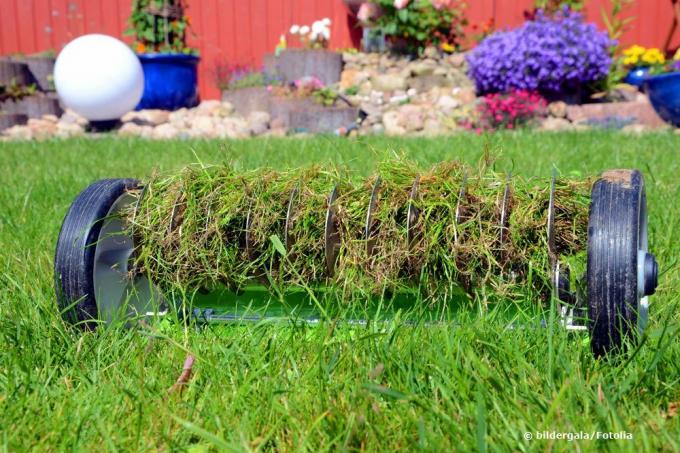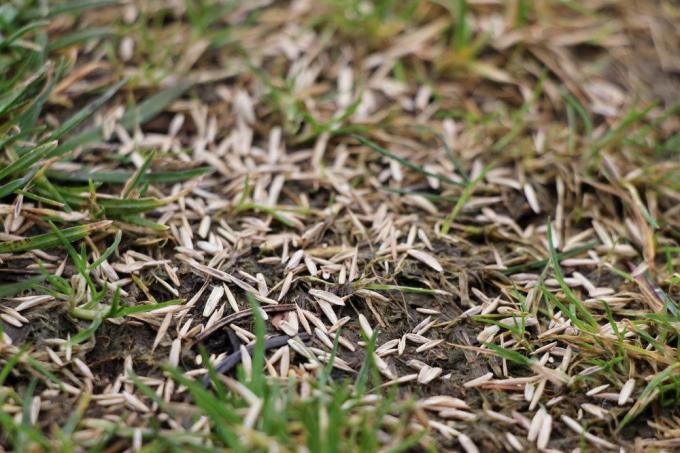
table of contents
- Remove autumn leaves
- Mow last time
- Scarifying
- Fertilize
- Close gaps
- frequently asked Questions
To the race To make it winterproof for the cold season, it is extremely important to prepare the area well. With the following work steps, the lawn can survive even freezing temperatures undamaged.
In a nutshell
- Prepare and winterize the lawn in late autumn
- First remove old leaves and objects that cast shadows
- then mow to a height of 4-5 cm
- then scarify extensively and enrich with fertilizer
- Finally, close any gaps in the lawn
Remove autumn leaves
Autumn leaves should not be left on the lawn over the winter months. Wilted leaves steal the poor incidence of light from the grass plants and cut off the oxygen supply. As a result, individual spots can turn yellow or brown, and in extreme cases the grasses even die. In addition, the decaying leaves ensure permanent moisture, which in connection with cool weather conditions can lead to diseases. Set up garden benches, porch swings, trampolines and other objects must also be removed from the lawn. Since these objects cast a clear shadow, they often cause lawn damage. The more sun and light the grass gets, the better it survives the winter.

- Rotting leaves encourage mold diseases
- Reduced exposure to sunlight supports the growth of moss
- Remove leaves from the lawn every week
- Use caution with a fan broom or rake
- Avoid injuries in the sward
- Compost leaves in wire mesh baskets
Mow last time
The lawn has to withstand a lot of stress in the harsh winter months. This includes prolonged rainfall, thick blankets of snow and frosty temperature values that bother her. So that the grass looks presentable again next spring, preparing for winter includes mowing one last time. The right time is crucial so that the lawn recovers sufficiently before the first frosts. Cutting the lawn too late can lead to severe frost damage. If the lawn is shorter in the cold season, it remains stronger and more resilient. However, the cutting height must not be too short, otherwise the grass will only perform its protective function in relation to the ground to a limited extent. This makes it easier for frost to penetrate the soil, which leads to damage in the root area.

- Carry out the last lawn cut of the year in October
- Mow a little later on very warm autumn days
- Depending on the weather, this is possible from beginning to mid-November at the latest
- Too long stalks break off in frost and snow
- After that, the grass rots and starts to go moldy
- The ideal cutting height is 4 to 5 cm
- It is essential to remove grass clippings, it must not be left lying around
- Otherwise too much moisture will build up underneath
Note: As a rule, grasses stop growing at temperatures below 8 ° to 10 ° Celsius.
Scarifying
In order to make the lawn winter-proof, it must be well ventilated again. In this way, a large part of the overgrown moss and disturbing weeds can be removed. Due to scarifying, the lawn can dry much faster in the rainy winter months. The more intensively the preparation of the lawn surface, the healthier the grass will survive the cold season.
- A lawn needs a lot of air to circulate
- Therefore scarify again in autumn
- Edit only the top layer
- Never set the scarifier too low
- Knives should reach about 3 mm into the ground
- Do not damage the sward or the roots of the turf

Fertilize
During the cold winter months, the grass pauses for a longer period of time. Therefore, it makes no sense to provide the grass plants with a nitrogen-rich fertilizer. Nevertheless, a final fertilization before the onset of winter is necessary in order to provide the lawn with important nutrients and to make it winter-proof. In contrast to the growing season in spring and summer, the lawn now needs other components that act like winter protection. In this way, the grasses no longer grow so long, but rather develop short and strong stalks.
- Fertilize in autumn during the last warm days
- Special autumn fertilizers are ideal for this
- Contains significantly more potassium and less nitrogen
- This increases the salt content in the cell sap of the blades of grass
- Acts like frost protection, as the freezing point of the cell sap drops
- The risk of frost damage is sustainably reduced
- Spread fertilizer evenly and without gaps
- Spreading by hand is possible
- Dosing can be carried out more precisely with fertilizer trolleys
- Always proceed according to the manufacturer's instructions

Tip: If certain areas were overlooked when fertilizing in autumn, they can be recognized immediately by their brown color in the next spring.
Close gaps
Now for the last step, winterizing the lawn. After the heat of summer, the lawn often has bare patches at the beginning of autumn. If the ground is still warm enough, unsightly gaps can be found through the Re-sowing conclude. The gardener can also prevent weeds from spreading. On the other hand, sowing the lawn too late at the end of autumn or in winter has little chance of the grasses germinating successfully. If the seeds do come up, this happens very unevenly. Then the grass plants that grow later do not match the desired look and the composition does not look harmonious.

- Use a special mixture for overseeding
- The seeds are covered with a layer of nutrients
- Get a growth advantage right away
- Are heavier, fall better between existing blades of grass
- Wind does not blow away grass seeds that quickly
- This improves the prospect of an even result
- First loosen up the soil slightly in the affected areas
- Then apply about 15 to 30 g of overseed per square meter
- Press firmly and water regularly
frequently asked Questions
The autumn fertilizer can even be applied twice so that the lawn becomes winterproof all around. In this context, the first fertilizer application takes place at the beginning of October. The second follows about four weeks later, but not later than mid-November.
Special reseeding mixtures are significantly more expensive than normal grass seeds, but the investment is worthwhile. The seeds have a direct boost in nutrients and grow much faster. In addition, due to the nutrient cover, birds do not recognize the seeds as conventional grains and do not eat them. So the lawn shines again before the onset of winter in a flawless shade of green and is completely winterproof.
So that the lawn still looks well-groomed in winter, the gardener should prepare the lawn edge with an edge cutter. Thanks to this parting, the grass plants do not grow into the neighboring beds at milder temperatures.

